
Roman mines
There are basically two kinds of exploitations:
A) Exploitations on primary deposits (lodes in gold quartz rocks).
The procedure followed in this kind of exploitation consisted in making big cuts or holes in the "open air" as the result of making the rock burst by using the changes of temperature caused by using first fire and the water (expansion and contraction of the rock). The pieces obtained were then washed at the bottom of the valley in order to extract and sift the gold. This system needed a good net of water channels, ponds and dams, placed almost always several kms from the extraction site.
The mines in the east of Galicia belong to this type, as for example, those in the valley of the Lor and in O Courel mountain range, which are called: Toca, Torubio, Monte Barreiro… and those in the area of A Fonsagrada and Navia de Suarna (As covas de Castañedo, Pedras Apañadas) as well as minor exploitations on lodes of quartz and gold sulphite in Barbante on the river Miño.
The procedure followd in this case started by using wells and underground galleries (ruina montium or arrugia) to pull down huge masses of alluvium soil which were then washed and left behind in order to get the gold. This method made it possible for the Romans to exploit those deposits that lay on the slopes of the valleys and the mountains. Water was canalized from the source of rivers to the deposits that, once they were full, were opened to cause the erosion and pulling down of the galleries excavated in the mountain. The alluvial mass was carried down towards the washing channels called "agogae". Huge galleries as the one in the next photograph were left. They can be visited today at "Médulas de Carucedo", mentioned below.
Apart from its richness of gold, Galicia was also important due to its abundance of tin, frequently found in the Atlantic coast, and in the inland valleys of the rivers Limia, Búbal and Tárrega. There was iron and marble in Incio.
These Galician mines were in exploitation during more than 250 years and they were very important between the centuries I and II AD.
We don't know exactly when the large scale exploitation of gold by the Romans in "Las Médulas" began.
The naming of "Procurador" for the mines in Astúrica and Gallaecia appears in an inscription of the year 79. It suggests that the exploitation of gold in "Las Médulas" was important at that time.
It isn't clear either the date when the exploitations there stopped although they started to decline in the century III AD.
The workers in the mines were indigenous people (free men but also mainly slaves) who lived in "castros", celtic stone buildings, close to the mines.
The technical direction of the works was in charge of Roman engineers and topographers, under the rigorous control of military units situated near the exploitations.
All gold mines were property of the Roman state and the mining districts were in charge of attorneys "Procuradores Metallorum", helped by subordinates and the military officers. The maximum authority for the mines in Astúrica and Gallaecia was the "Procurator", located in the village of Astúrica Augusta (Astorga).
Taking into account the information of the chronicler Plinio, about 6500 kg of gold were taken from the mines in the north-west of Hispania (Gallaecia) in a year and up to 600 million metres were removed from nearly 500 mines opened in three centuries where between 10,000 and 15,000 men worked.
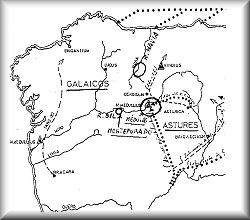 Manual exploitation of mineral veins and mainly of gold sand banks in rivers (fluvial gold placeres) were already important in Pre-roman time in Galicia.
The Romans transformed these activities into a large-scale extraction industry, studying previously the places where gold was most abundant and those where gold could be exploited using new extraction systems.
Manual exploitation of mineral veins and mainly of gold sand banks in rivers (fluvial gold placeres) were already important in Pre-roman time in Galicia.
The Romans transformed these activities into a large-scale extraction industry, studying previously the places where gold was most abundant and those where gold could be exploited using new extraction systems.
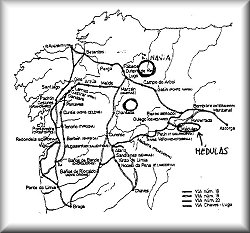 The new exploitations were gathered in the eastern side of Galicia and the western side of Asturias, and León and in the middle valley of the rivers Sil and Lar. They were mineral sites where the richness of gold made the effort necessary to extract it in huge quantities worth doing.
The new exploitations were gathered in the eastern side of Galicia and the western side of Asturias, and León and in the middle valley of the rivers Sil and Lar. They were mineral sites where the richness of gold made the effort necessary to extract it in huge quantities worth doing.
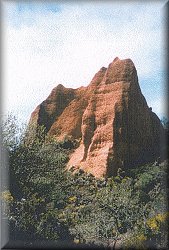 B) Exploitation on secondary deposits:
Lodes on alluviums (deposits of materials carried down by the rivers) and fluvial placeres (river sand banks). This second type of extraction has left monumental examples in the landscape, as you can notice in the photograph.
B) Exploitation on secondary deposits:
Lodes on alluviums (deposits of materials carried down by the rivers) and fluvial placeres (river sand banks). This second type of extraction has left monumental examples in the landscape, as you can notice in the photograph.
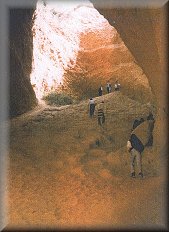 These "alluviums" were composed of horizontal deposit layers where clay and pebbles alternated and where gold nuggets could be found.
Included in this type of exploitations, we can mention the spectacular "Médulas de Carucedo" and some other mines in the valleys of the rivers Eria and Duema and in the Teleno mountain range (in León), as well as the Galician mines in the "Lago de Maside", in Barreiras de Caldesiños" (Bolo) and also those in the slopes of the river Sil: "Bembibre", "Quereño", "Montefurado", which were quite important in Roman times.
These "alluviums" were composed of horizontal deposit layers where clay and pebbles alternated and where gold nuggets could be found.
Included in this type of exploitations, we can mention the spectacular "Médulas de Carucedo" and some other mines in the valleys of the rivers Eria and Duema and in the Teleno mountain range (in León), as well as the Galician mines in the "Lago de Maside", in Barreiras de Caldesiños" (Bolo) and also those in the slopes of the river Sil: "Bembibre", "Quereño", "Montefurado", which were quite important in Roman times.
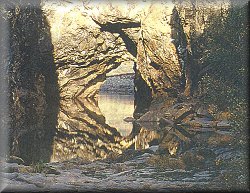 The photo shows "Montefurado" as it was left after the Romans extracted gold from it.
The photo shows "Montefurado" as it was left after the Romans extracted gold from it.
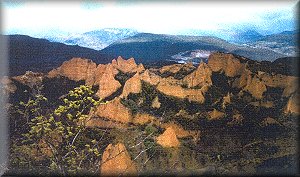 The UNESCO declared World Heritage Site the spot consisting of the old mines of "Las Médulas", situated in El Bierzo, (León), in February 1998. this beautiful region became the first European scenery that got that distinction.
"Las Médulas" aren't a natural landscape in the strict sense of the word but their moving beauty is due to the effort made by man to obtain gold.
The system of exploitation by moving soil meant one of the first attacks against nature although it also brought a huge richness couce to the Imperial Heritage.
The UNESCO declared World Heritage Site the spot consisting of the old mines of "Las Médulas", situated in El Bierzo, (León), in February 1998. this beautiful region became the first European scenery that got that distinction.
"Las Médulas" aren't a natural landscape in the strict sense of the word but their moving beauty is due to the effort made by man to obtain gold.
The system of exploitation by moving soil meant one of the first attacks against nature although it also brought a huge richness couce to the Imperial Heritage.